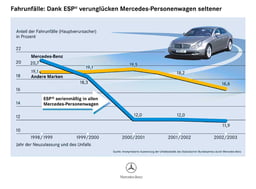Traffic collision

Traffic collision

| Vehicle collision | |
|---|---|
| Other names | Traffic accident, motor vehicle accident, car accident, automobile accident, road traffic collision, road accident, road traffic accident, wreck, car crash, car wreck, car smash, knockdown, plowthrough, fender bender, pileup, T-bone |
| Ahead-on collisioninvolving two vehicles | |
| Specialty | Emergency medicine |
A traffic collision, also called a motor vehicle collision (MVC) among other terms, occurs when a vehicle collides with another vehicle, pedestrian, animal, road debris, or other stationary obstruction, such as a tree, pole or building. Traffic collisions often result in injury, death, and property damage.
A number of factors contribute to the risk of collisions, including vehicle design, speed of operation, road design, road environment, and driver skill, impairment due to alcohol or drugs, and behavior, notably distracted driving, speeding and street racing. Worldwide, motor vehicle collisions lead to death and disability as well as financial costs to both society and the individuals involved.
In 2013, 54 million people worldwide sustained injuries from traffic collisions.[2] This resulted in 1.4 million deaths in 2013, up from 1.1 million deaths in 1990.[3] About 68,000 of these occurred in children less than five years old.[3] Almost all high-income countries have decreasing death rates, while the majority of low-income countries have increasing death rates due to traffic collisions. Middle-income countries have the highest rate with 20 deaths per 100,000 inhabitants, accounting for 80% of all road fatalities with 52% of all vehicles. While the death rate in Africa is the highest (24.1 per 100,000 inhabitants), the lowest rate is to be found in Europe (10.3 per 100,000 inhabitants).[4]
| Vehicle collision | |
|---|---|
| Other names | Traffic accident, motor vehicle accident, car accident, automobile accident, road traffic collision, road accident, road traffic accident, wreck, car crash, car wreck, car smash, knockdown, plowthrough, fender bender, pileup, T-bone |
| Ahead-on collisioninvolving two vehicles | |
| Specialty | Emergency medicine |
Terminology
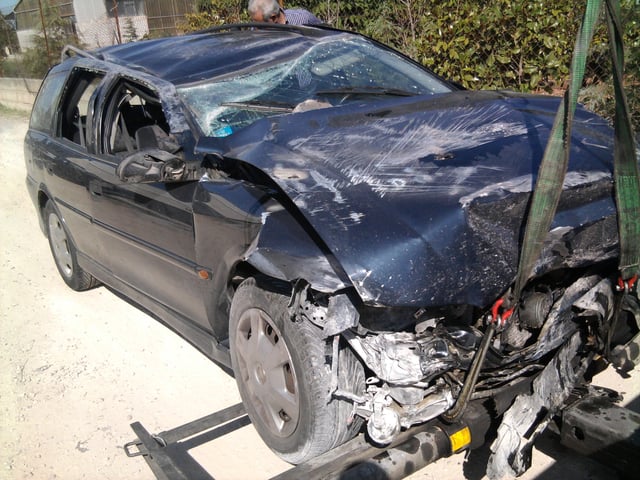
An Opel Vectra involved in a rollover crash

A rolled over box truck being handled by fire fighters in Jakarta, Indonesia
Traffic collisions can be classified by general types.
Types of collision include head-on, road departure, rear-end, side collisions, and rollovers.
Many different terms are commonly used to describe vehicle collisions.
The World Health Organization uses the term road traffic injury,[5] while the U.S. Census Bureau uses the term motor vehicle accidents (MVA), [6] and Transport Canada uses the term "motor vehicle traffic collision" (MVTC).[7] Other common terms include auto accident, car accident, car crash, car smash, car wreck, motor vehicle collision (MVC), personal injury collision (PIC), road accident, road traffic accident (RTA), road traffic collision (RTC), and road traffic incident (RTI) as well as more unofficial terms including smash-up, pile-up, and fender bender.
Some organizations have begun to avoid the term "accident", instead preferring terms such as "collision", "crash" or "incident".[8][9] This is because the term "accident" implies that there is no-one to blame, whereas most traffic collisions are the result of driving under the influence, excessive speed, distractions such as mobile phones or other risky behavior.[10][11]
Historically, in the United States, the use of terms other than "accidents" had been criticized for holding back safety improvements, based on the idea that a culture of blame may discourage the involved parties from fully disclosing the facts, and thus frustrate attempts to address the real root causes.[12]
Health effects
Psychological
Following collisions, long-lasting psychological trauma may occur.[13] These issues may make those who have been in a crash afraid to drive again. In some cases, the psychological trauma may affect individuals' life can cause difficulty to go to work, attend school, or perform family responsibilities.[14]
Physical
A number of physical injuries can commonly result from the blunt force trauma caused by a collision, ranging from bruising and contusions to catastrophic physical injury (e.g., paralysis) or death.
Causes
A 1985 study by K. Rumar, using British and American crash reports as data, suggested 57% of crashes were due solely to driver factors, 27% to combined roadway and driver factors, 6% to combined vehicle and driver factors, 3% solely to roadway factors, 3% to combined roadway, driver, and vehicle factors, 2% solely to vehicle factors, and 1% to combined roadway and vehicle factors.[15] Reducing the severity of injury in crashes is more important than reducing incidence and ranking incidence by broad categories of causes is misleading regarding severe injury reduction.
Vehicle and road modifications are generally more effective than behavioral change efforts with the exception of certain laws such as required use of seat belts, motorcycle helmets and graduated licensing of teenagers.[16]
Human factors

Man with visible facial scars resulting from a car collision
Human factors in vehicle collisions include anything related to drivers and other road users that may contribute to a collision.
Examples include driver behavior, visual and auditory acuity, decision-making ability, and reaction speed.
A 1985 report based on British and American crash data found driver error, intoxication and other human factors contribute wholly or partly to about 93% of crashes.[15]
Drivers distracted by mobile devices had nearly four times greater risk of crashing their cars than those who were not. Dialing a phone is the most dangerous distraction, increasing a drivers’ chance of crashing by 12 times, followed by reading or writing, which increased the risk by 10 times.[17]
An RAC survey of British drivers found 78% of drivers thought they were highly skilled at driving, and most thought they were better than other drivers, a result suggesting overconfidence in their abilities. Nearly all drivers who had been in a crash did not believe themselves to be at fault.[18] One survey of drivers reported that they thought the key elements of good driving were:[19]
controlling a car including a good awareness of the car's size and capabilities
reading and reacting to road conditions, weather, road signs and the environment
alertness, reading and anticipating the behavior of other drivers.
Although proficiency in these skills is taught and tested as part of the driving exam, a "good" driver can still be at a high risk of crashing because:
...the feeling of being confident in more and more challenging situations is experienced as evidence of driving ability, and that 'proven' ability reinforces the feelings of confidence.
Confidence feeds itself and grows unchecked until something happens – a near-miss or an accident.[19]
An AXA survey concluded Irish drivers are very safety-conscious relative to other European drivers. However, this does not translate to significantly lower crash rates in Ireland.[20]
Accompanying changes to road designs have been wide-scale adoptions of rules of the road alongside law enforcement policies that included drink-driving laws, setting of speed limits, and speed enforcement systems such as speed cameras. Some countries' driving tests have been expanded to test a new driver's behavior during emergencies, and their hazard perception.
There are demographic differences in crash rates.
For example, although young people tend to have good reaction times, disproportionately more young male drivers feature in collisions,[21] with researchers observing that many exhibit behaviors and attitudes to risk that can place them in more hazardous situations than other road users.[19] This is reflected by actuaries when they set insurance rates for different age groups, partly based on their age, sex, and choice of vehicle. Older drivers with slower reactions might be expected to be involved in more collisions, but this has not been the case as they tend to drive less and, apparently, more cautiously.[22] Attempts to impose traffic policies can be complicated by local circumstances and driver behavior.
In 1969 Leeming warned that there is a balance to be struck when "improving" the safety of a road:[23]
Conversely, a location that does not look dangerous may have a high crash frequency.
This is, in part, because if drivers perceive a location as hazardous, they take more care.
Collisions may be more likely to happen when hazardous road or traffic conditions are not obvious at a glance, or where the conditions are too complicated for the limited human machine to perceive and react in the time and distance available. High incidence of crashes is not indicative of high injury risk. Crashes are common in areas of high vehicle congestion, but fatal crashes occur disproportionately on rural roads at night when traffic is relatively light.
This phenomenon has been observed in risk compensation research, where the predicted reductions in collision rates have not occurred after legislative or technical changes. One study observed that the introduction of improved brakes resulted in more aggressive driving,[24] and another argued that compulsory seat belt laws have not been accompanied by a clearly attributed fall in overall fatalities.[25] Most claims of risk compensation offsetting the effects of vehicle regulation and belt use laws have been discredited by research using more refined data.[16]
In the 1990s, Hans Monderman's studies of driver behavior led him to the realization that signs and regulations had an adverse effect on a driver's ability to interact safely with other road users. Monderman developed shared space principles, rooted in the principles of the woonerven of the 1970s. He concluded that the removal of highway clutter, while allowing drivers and other road users to mingle with equal priority, could help drivers recognize environmental clues. They relied on their cognitive skills alone, reducing traffic speeds radically and resulting in lower levels of road casualties and lower levels of congestion.[26]
Some crashes are intended; staged crashes, for example, involve at least one party who hopes to crash a vehicle in order to submit lucrative claims to an insurance company.[27] In the United States during the 1990s, criminals recruited Latin immigrants to deliberately crash cars, usually by cutting in front of another car and slamming on the brakes. It was an illegal and risky job, and they were typically paid only $100. Jose Luis Lopez Perez, a staged crash driver, died after one such maneuver, leading to an investigation that uncovered the increasing frequency of this type of crash.[28]
Motor vehicle speed
The U.S. Department of Transportation's Federal Highway Administration review research on traffic speed in 1998.[29] The summary says:
The evidence shows the risk of having a crash is increased both for vehicles traveling slower than the average speed, and for those traveling above the average speed.
The risk of being injured increases exponentially with speeds much faster than the median speed.
The severity/ lethality of a crash depends on the vehicle speed change at impact.
There is limited evidence suggesting lower speed limits result in lower speeds on a system-wide basis.
Most crashes related to speed involve speed too fast for the conditions.
More research is needed to determine the effectiveness of traffic calming.
The Road and Traffic Authority (RTA) of the Australian state of New South Wales (NSW) asserts speeding (traveling too fast for the prevailing conditions or above the posted speed limit[30]) is a factor in about 40 percent of road deaths.[31] The RTA also say speeding increases the risk of a crash and its severity.[31] On another web page, the RTA qualify their claims by referring to one specific piece of research from 1997, and writes "research has shown that the risk of a crash causing death or injury increases rapidly, even with small increases above an appropriately set speed limit."[32]
The contributory factor report in the official British road casualty statistics show for 2006, that "exceeding speed limit" was a contributory factor in 5% of all casualty crashes (14% of all fatal crashes), and "traveling too fast for conditions" was a contributory factor in 11% of all casualty crashes (18% of all fatal crashes).[33]
Assured clear distance ahead
Driver impairment
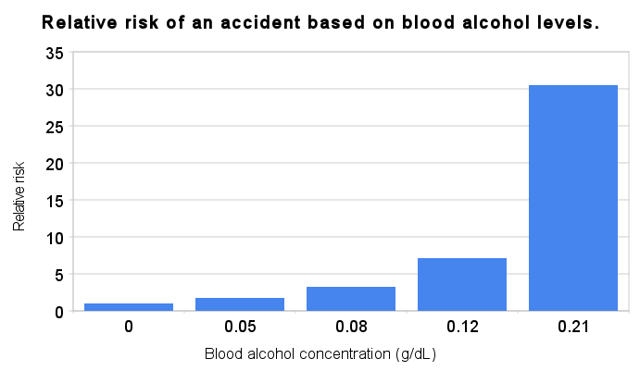
Relative risk of collisions based on blood alcohol levels[39]

A graph outlining the relationship between number of hours driven and the percent of commercial truck crashes related to driver fatigue.[41]
Driver impairment describes factors that prevent the driver from driving at their normal level of skill.
Common impairments include:
- Alcohol
According to the Government of Canada, coroner reports from 2008 suggested almost 40% of fatally injured drivers consumed some quantity of alcohol before the collision.[40]
- Physical impairment
Poor eyesight and/or physical impairment, with many jurisdictions setting simple sight tests and/or requiring appropriate vehicle modifications before being allowed to drive;
- Youth
Insurance statistics demonstrate a notably higher incidence of collisions and fatalities among drivers aged in their teens or early twenties, with insurance rates reflecting this data.
These drivers have the highest incidence of both collisions and fatalities among all driver age groups, a fact that was observed well before the advent of mobile phones.
Females in this age group exhibit somewhat lower collision and fatality rates than males but still register well above the median for drivers of all ages.
Also within this group, the highest collision incidence rate occurs within the first year of licensed driving.
For this reason, many US states have enacted a zero-tolerance policy wherein receiving a moving violation within the first six months to one year of obtaining a license results in automatic license suspension. No US state allows fourteen year-olds to obtain drivers’ licenses any longer.
- Old age
Old age, with some jurisdictions requiring driver retesting for reaction speed and eyesight after a certain age.
- Sleep deprivation
Various factors such as fatigue or sleep deprivation might increase the risk, or numbers of hours driving might increase the risk of an accident.[42]
- Drug use
Including some prescription drugs, over the counter drugs (notably antihistamines, opioids and muscarinic antagonists), and illegal drugs.
- Distraction
Research suggests that the driver's attention is affected by distracting sounds such as conversations and operating a mobile phone while driving. Many jurisdictions now restrict or outlaw the use of some types of phone within the car. Recent research conducted by British scientists suggests that music can also have an effect; classical music is considered to be calming, yet too much could relax the driver to a condition of distraction. On the other hand, hard rock may encourage the driver to step on the acceleration pedal, thus creating a potentially dangerous situation on the road.[43]
Cell phone use is an increasingly significant problem on the roads and as the U.S. National Safety Council compiled more than 30 studies postulating that hands-free is not a safer option, because the brain remains distracted by the conversation and cannot focus solely on the task of driving.[44]
Intent
Some traffic collisions are caused intentionally by a driver.
For example, an accident may be caused by a driver who intends to commit suicide.[45] Accidents may also be intentionally caused by people who hope to make an insurance claim against the other driver, or may be staged for such purposes as insurance fraud.[46][47] Motor vehicles may also be involved in collisions as part of a deliberate effort to hurt other people, such as in a vehicle-ramming attack.[48]
- Combinations of factors
Several conditions can combine to create a much worse situation, for example:
Combining low doses of alcohol and cannabis has a more severe effect on driving performance than either cannabis or alcohol in isolation,[49] or
Taking recommended doses of several drugs together, which individually do not cause impairment, may combine to bring on drowsiness or other impairment.
This could be more pronounced in an elderly person whose renal function is less efficient than a younger person's.[50]
Thus, there are situations when a person may be impaired, but still legally allowed to drive, and becomes a potential hazard to themselves and other road users.
Pedestrians or cyclists are affected in the same way and can similarly jeopardize themselves or others when on the road.
Road design
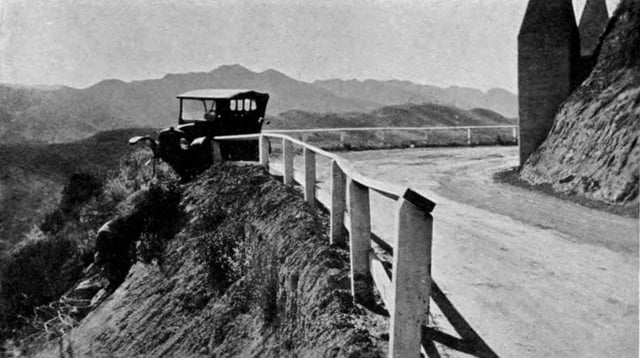
A potential long fall stopped by an early guardrail, ca. 1920.
A 1985 US study showed that about 34% of serious crashes had contributing factors related to the roadway or its environment.
Most of these crashes also involved a human factor.[15] The road or environmental factor was either noted as making a significant contribution to the circumstances of the crash, or did not allow room to recover.
In these circumstances, it is frequently the driver who is blamed rather than the road; those reporting the collisions have a tendency to overlook the human factors involved, such as the subtleties of design and maintenance that a driver could fail to observe or inadequately compensate for.[51]
Research has shown that careful design and maintenance, with well-designed intersections, road surfaces, visibility and traffic control devices, can result in significant improvements in collision rates.
Individual roads also have widely differing performance in the event of an impact.
In Europe, there are now EuroRAP tests that indicate how "self-explaining" and forgiving a particular road and its roadside would be in the event of a major incident.
In the UK, research has shown that investment in a safe road infrastructure program could yield a ⅓ reduction in road deaths, saving as much as £6 billion per year.[52] A consortium of 13 major road safety stakeholders have formed the Campaign for Safe Road Design, which is calling on the UK Government to make safe road design a national transport priority.
Vehicle design and maintenance
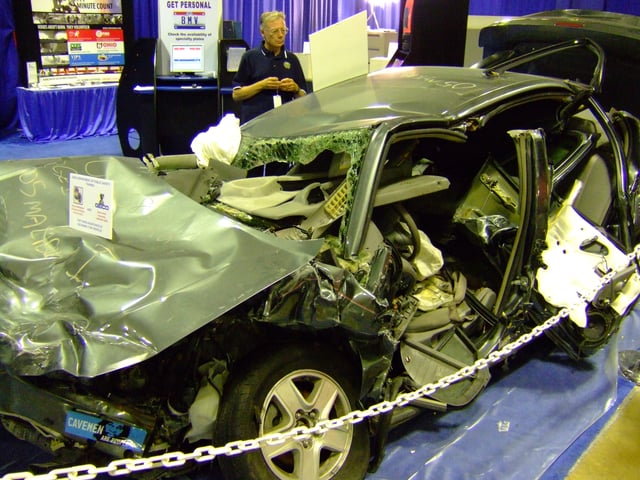
A 2005 Chevrolet Malibu involved in a rollover crash
- Seat belts
Research has shown that, across all collision types, it is less likely that seat belts were worn in collisions involving death or serious injury, rather than light injury; wearing a seat belt reduces the risk of death by about 45 percent.[53] Seat belt use is controversial, with notable critics such as Professor John Adams suggesting that their use may lead to a net increase in road casualties due to a phenomenon known as risk compensation.[54] However, actual observation of driver behaviors before and after seat belt laws does not support the risk compensation hypothesis. Several important driving behaviors were observed on the road before and after the belt use law was enforced in Newfoundland, and in Nova Scotia during the same period without a law. Belt use increased from 16 percent to 77 percent in Newfoundland and remained virtually unchanged in Nova Scotia. Four driver behaviors (speed, stopping at intersections when the control light was amber, turning left in front of oncoming traffic, and gaps in following distance) were measured at various sites before and after the law. Changes in these behaviors in Newfoundland were similar to those in Nova Scotia, except that drivers in Newfoundland drove slower on expressways after the law, contrary to the risk compensation theory.[55]
- Maintenance
A well-designed and well-maintained vehicle, with good brakes, tires and well-adjusted suspension will be more controllable in an emergency and thus be better equipped to avoid collisions.
Some mandatory vehicle inspection schemes include tests for some aspects of roadworthiness, such as the UK's MOT test or German TÜV conformance inspection.
The design of vehicles has also evolved to improve protection after collision, both for vehicle occupants and for those outside of the vehicle. Much of this work was led by automotive industry competition and technological innovation, leading to measures such as Saab's safety cage and reinforced roof pillars of 1946, Ford´s 1956 Lifeguard ]]
In the early 1970s, British Leyland started an intensive programme of vehicle safety research, producing a number of prototype experimental safety vehicles demonstrating various innovations for occupant and pedestrian protection such as air bags, anti-lock brakes, impact-absorbing side-panels, front and rear head restraints, run-flat tires, smooth and deformable front-ends, impact-absorbing bumpers, and retractable headlamps.[56] Design has also been influenced by government legislation, such as the Euro NCAP impact test.
Common features designed to improve safety include thicker pillars, safety glass, interiors with no sharp edges, stronger bodies, other active or passive safety features, and smooth exteriors to reduce the consequences of an impact with pedestrians.
The UK Department for Transport publish road casualty statistics for each type of collision and vehicle through its Road Casualties Great Britain report.[57] These statistics show a ten to one ratio of in-vehicle fatalities between types of car.
In most cars, occupants have a 2–8% chance of death in a two-car collision.
- Center of gravity
Some crash types tend to have more serious consequences.
Rollovers have become more common in recent years, perhaps due to increased popularity of taller SUVs, people carriers, and minivans, which have a higher center of gravity than standard passenger cars. Rollovers can be fatal, especially if the occupants are ejected because they were not wearing seat belts (83% of ejections during rollovers were fatal when the driver did not wear a seat belt, compared to 25% when they did).[53] After a new design of Mercedes Benz notoriously failed a 'moose test' (sudden swerving to avoid an obstacle), some manufacturers enhanced suspension using stability control linked to an anti-lock braking system to reduce the likelihood of rollover. After retrofitting these systems to its models in 1999–2000, Mercedes saw its models involved in fewer crashes.[58]
Now, about 40% of new US vehicles, mainly the SUVs, vans and pickup trucks that are more susceptible to rollover, are being produced with a lower center of gravity and enhanced suspension with stability control linked to its anti-lock braking system to reduce the risk of rollover and meet US federal requirements that mandate anti-rollover technology by September 2011.[59]
- Motorcycles
Motorcyclists have little protection other than their clothing and helmets. This difference is reflected in the casualty statistics, where they are more than twice as likely to suffer severely after a collision. In 2005, there were 198,735 road crashes with 271,017 reported casualties on roads in Great Britain. This included 3,201 deaths (1.1%) and 28,954 serious injuries (10.7%) overall. Of these casualties 178,302 (66%) were car users and 24,824 (9%) were motorcyclists, of whom 569 were killed (2.3%) and 5,939 seriously injured (24%).[60]
Sociological factors
Studies in United States have shown that poor people have a greater risk of dying in a car crash than people who are well-off.[61] Car deaths are also higher in poorer states.[62]
Other
Other possibly hazardous factors that may alter a driver's soundness on the road includes:
Irritability,[65]
Following specifically distinct rules too bureaucratically, inflexibly or rigidly when unique circumstances might suggest otherwise[66]
Sudden swerving into somebody's blind spot without first clearly making oneself visible through the wing mirror[67]
Unfamiliarity with one's dashboard features, center console or other interior handling devices after a recent car purchase[68]
Lack of visibility due to windshield design or sun glare[69]
Distraction by scenery, a sexually attractive person or sexually suggestive advertising[70][71]
Traffic safety culture, a variety of aspects of safety culture could impact on the number of crashes.[72]
Prevention
A large body of knowledge has been amassed on how to prevent car crashes, and reduce the severity of those that do occur.
United Nations
Owing to the global and massive scale of the issue, with predictions that by 2020 road traffic deaths and injuries will exceed HIV/AIDS as a burden of death and disability,[73] the United Nations and its subsidiary bodies have passed resolutions and held conferences on the issue.
The first United Nations General Assembly resolution and debate was in 2003[74] The World Day of Remembrance for Road Traffic Victims was declared in 2005. In 2009 the first high level ministerial conference on road safety was held in Moscow.
The World Health Organization, a specialized agency of the United Nations Organization, in its Global Status Report on Road Safety 2009, estimates that over 90% of the world’s fatalities on the roads occur in low-income and middle-income countries, which have only 48% of the world’s registered vehicles, and predicts road traffic injuries will rise to become the fifth leading cause of death by 2030.[75]
Collision migration
Collisions migration refers to a situation where action to reduce road traffic collisions in one place may result in those collisions resurfacing elsewhere.[76] For example, an accident blackspot may occur at a dangerous bend.[77] The treatment for this may be to increase signage, post an advisory speed limit, apply a high-friction road surface, add crash barriers or any one of a number of other visible interventions. The immediate result may be to reduce collisions at the bend, but the subconscious relaxation on leaving the "dangerous" bend may cause drivers to act with fractionally less care on the rest of the road, resulting in an increase in collisions elsewhere on the road, and no overall improvement over the area. In the same way, increasing familiarity with the treated area will often result in a reduction over time to the previous level of care (regression to the mean) and may result in faster speeds around the bend due to perceived increased safety (risk compensation).
Epidemiology
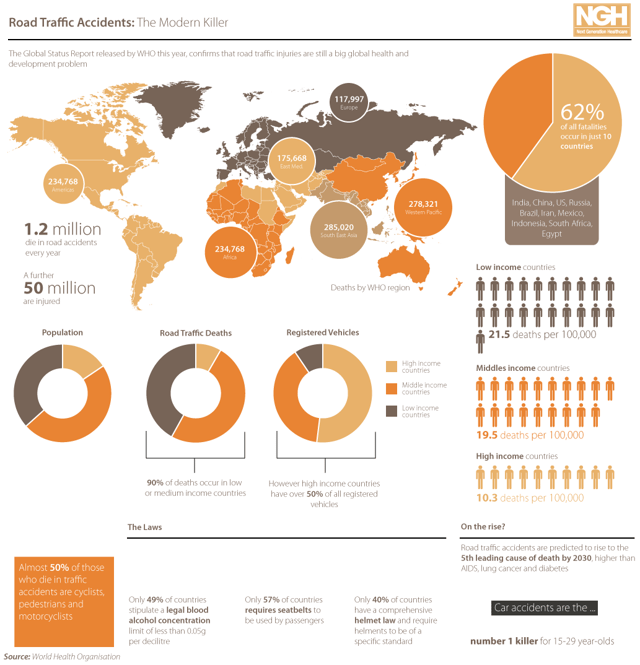
Info graphic of statistics

Deaths for road traffic collisions per 100,000 inhabitants in 2012[78] no data less than 5 5-10 10-15 15-20 20-25 25-30 30-35 35-40 more than 40

Road fatalities per vehicle-km (fatalities per 1 billion km) no data < 5.0 5.0-6.5 6.5-8.0 8.0-9.5 9.5-11.0 11.0-12.5 12.5-14.0 14.0-15.5 15.5-17.0 17.0-18.5 18.5-20.0 > 20.0
In 2004 50 million more were injured in motor vehicle collisions.
In 2013, between 1.25 million and 1.4 million people were killed in traffic accidents,[3][79] up from 1.1 million deaths in 1990.[3] That number represents about 2.5% of all deaths.[3]. Approximately 50 million additional people were injured in traffic accidents,[79] a number unchanged from 2004.[5][80]
India recorded 105,000 traffic deaths in a year, followed by China with over 96,000 deaths.[81] This makes motor vehicle collisions the leading cause of injury and death among children worldwide 10–19 years old (260,000 children die a year, 10 million are injured)[82] and the sixth leading preventable cause of death in the United States[83] (45,800 people died and 2.4 million were injured in 2005).[84] In the state of Texas alone, there were a total of 415,892 traffic collisions, including 3,005 fatal crashes in 2012. In Canada, they are the cause of 48% of severe injuries.[85]
Crash rates
The safety performance of roadways is almost always reported as a rate.
That is, some measure of harm (deaths, injuries, or number of crashes) divided by some measure of exposure to the risk of this harm.
Rates are used so the safety performance of different locations can be compared, and to prioritize safety improvements.
Common rates related to road traffic fatalities include the number of deaths per capita, per registered vehicle, per licensed driver, or per vehicle mile or kilometer traveled.
Simple counts are almost never used.
The annual count of fatalities is a rate, namely, the number of fatalities per year.
There is no one rate that is superior to others in any general sense.
The rate to be selected depends on the question being asked – and often also on what data are available.
What is important is to specify exactly what rate is measured and how it relates to the problem being addressed.
Some agencies concentrate on crashes per total vehicle distance traveled.
Others combine rates.
The U.S. state of Iowa, for example, selects high collision locations based on a combination of crashes per million miles traveled, crashes per mile per year, and value loss (crash severity).[86]
Fatality

[257] statistic
The definition of a road-traffic fatality varies from country to country.
In the United States, the definition used in the Fatality Analysis Reporting System (FARS)[87] run by the National Highway Traffic Safety Administration (NHTSA) is a person who dies within 30 days of a crash on a US public road involving a vehicle with an engine, the death being the result of the crash. In the U.S., therefore, if a driver has a non-fatal heart attack that leads to a road-traffic crash that causes death, that is a road-traffic fatality. However, if the heart attack causes death prior to the crash, then that is not a road-traffic fatality.
The definition of a road-traffic fatality can change with time in the same country.
For example, fatality was defined in France as a person who dies in the six days (pre 2005) after the collision and was subsequently changed to the 30 days (post 2005) after the collision.[88]
History
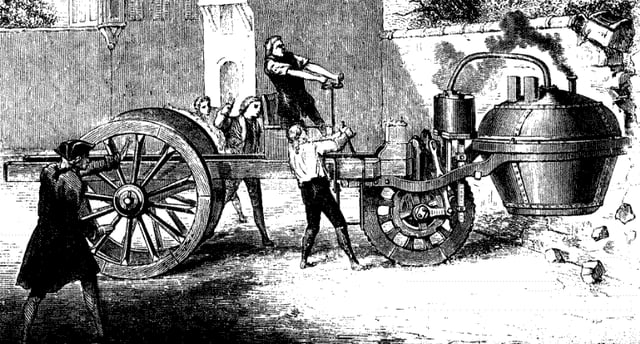
The fardier à vapeur of Nicolas-Joseph Cugnot allegedly crashed into a wall in 1771.[89]

Truck collision with house in Compstall, United Kingdom (1914)
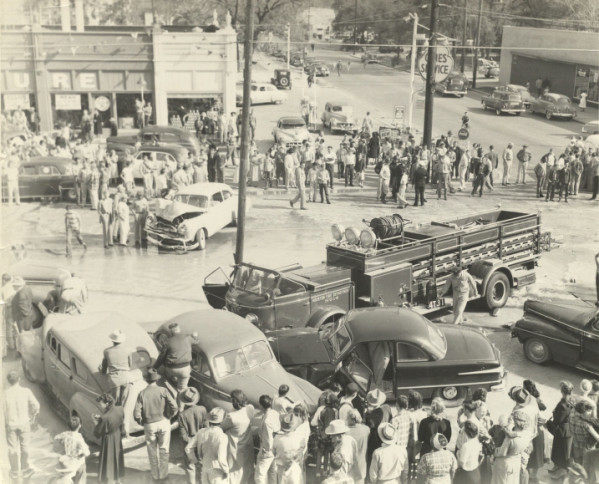
A traffic collision from 1952
The British road engineer J. J. Leeming, compared the statistics for fatality rates in Great Britain, for transport-related incidents both before and after the introduction of the motor vehicle, for journeys, including those once by water that now are undertaken by motor vehicle:[23] For the period 1863–1870 there were: 470 fatalities per million of population (76 on railways, 143 on roads, 251 on water); for the period 1891–1900 the corresponding figures were: 348 (63, 107, 178); for the period 1931–1938: 403 (22, 311, 70) and for the year 1963: 325 (10, 278, 37).[23]*Road%20Accidents%3A%20Prevent%20or%20]]*Road%20Accidents%3A%20Prevent%20or%20]]*Road%20Accidents%3A%20Prevent%20or%20]]*Road%20Accidents%3A%20Prevent%20or%20]]*Road%20Accidents%3A%20Prevent%20or%20]]*Road%20Accidents%3A%20Prevent%20or%20]]*Leeming concluded that the data showed that "travel accidents may even have been more frequent a century ago than they are now, at least for men".
In 1969, a British road engineer compared the circumstances around road deaths as reported in various American states before the widespread introduction of 55 mph (89 km/h) speed limits and drunk-driving laws.[23]
They took into account thirty factors which it was thought might affect the death rate.
Among these were included the annual consumption of wine, of spirits and of malt beverages—taken individually—the amount spent on road maintenance, the minimum temperature, certain of the legal measures such as the amount spent on police, the number of police per 100,000 inhabitants, the follow-up programme on dangerous drivers, the quality of driver testing, and so on.
The thirty factors were finally reduced to six by eliminating those found to have small or negligible effect.
The final six were: (a) The percentage of the total state highway mileage that is rural (b) The percent increase in motor vehicle registration (c) The extent of motor vehicle inspection (d) The percentage of state-administered highway that is surfaced (e) The average yearly minimum temperature (f) The income per capita These are placed in descending order of importance.
These six accounted for 70% of the variations in the rate.
Society and culture
Economic costs
The global economic cost of MVCs was estimated at $518 billion per year in 2003, and $100 billion in developing countries.[80] The Center for Disease Control and Prevention estimated the U.S. cost in 2000 at $230 billion.[93] A 2010 US report estimated costs of $277 billion, which included lost productivity, medical costs, legal and court costs, emergency service costs (EMS), insurance administration costs, congestion costs, property damage, and workplace losses. "The value of societal harm from motor vehicle crashes, which includes both economic impacts and valuation for lost quality-of-life, was $870.8 billion in 2010. Sixty-eight percent of this value represents lost quality-of-life, while 32 percent are economic impacts."[94]
Legal consequences
There are a number of possible legal consequences for causing a traffic collision, including:
Traffic citations: drivers who are involved in a collision may receive one or more traffic citations for improper driving conduct such as speeding, failure to obey a traffic control device, or driving under the influence of drugs or alcohol.[95] Convictions for traffic violations are usually penalized with fines, and for more severe offenses, the suspension or revocation of driving privileges.[96]
Civil lawsuits: a driver who causes a traffic collision may be sued for damages resulting from the accident, including damages to property and injuries to other persons.[97]
Criminal prosecution: More severe driving misconduct, including impaired driving, may result in criminal charges against the driver. In the event of a fatality, a charge of vehicular homicide is occasionally prosecuted, especially in cases involving alcohol.[98] Convictions for alcohol offenses may result in the revocation or long term suspension of the driver's license, and sometimes jail time, mandatory drug or alcohol rehabilitation, or both.[99]
Fraud
Sometimes, people may make false insurance claims or commit insurance fraud by staging collisions or jumping in front of moving cars.[100]
United States
In the United States, individuals involved in motor vehicle collisions may be held financially liable for the consequences of a collision, including property damage, and injuries to passengers and drivers.[97] Where another driver's vehicle is damaged as the result of an accident, some states allow the owner of the vehicle to recover both the cost of repair for the diminished value of the vehicle from the at-fault driver.[101] Because the financial liability that results from causing an accident is so high, most U.S. states require drivers to carry liability insurance to cover these potential costs. In the event of serious injuries or fatalities, it is possible for injured persons to seek compensation in excess of the at-fault driver's insurance coverage.[102]
In some cases, involving a defect in the design or manufacture of motor vehicles, such as where defective design results in SUV rollovers[103] or sudden unintended acceleration,[104] accidents caused by defective tires,[105] or where injuries are caused or worsened as a result of defective airbags,[106] it is possible that the manufacturer will face a class action lawsuit.
Art
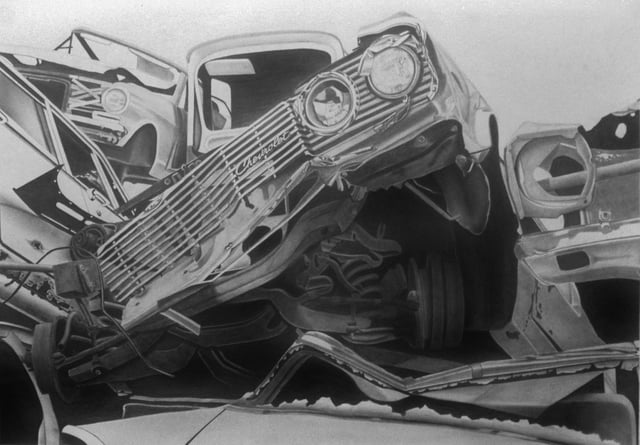
American Landscape by Jan A. Nelson (graphite on Strathmore rag, 1974)
Cars have come to represent a part of the American Dream of ownership coupled with the freedom of the road. The violence of a car wreck provides a counterpoint to that promise and is the subject of artwork by a number of artists, such as John Salt, Jan Anders Nelson, and Li Yan. Though English, John Salt was drawn to American landscapes of wrecked vehicles like Desert Wreck (airbrushed oil on linen, 1972).[107] Similarly, Jan Anders Nelson works with the wreck in its resting state in junkyards or forests, or as elements in his paintings and drawings. American Landscape [108] is one example of Nelson´s focus on the violence of the wreck with cars and trucks piled into a heap, left to the forces of nature and time. This recurring theme of violence is echoed in the work of Li Yan. His painting Accident Nº 6 looks at the energy released during a crash.[109][110][111]
Andy Warhol used newspaper pictures of car wrecks with dead occupants in a number of his Disaster series of silkscreened canvases.[112] John Chamberlain used components of wrecked cars (such as bumpers and crumpled sheet metal fenders) in his welded sculptures.[113]
See also
Accident management
Assured Clear Distance Ahead
Black ice
Crash test
Crashworthiness
Defensive driving
Forensic engineering
Global road safety for workers
Hill jumping
List of countries by traffic-related death rate
List of traffic collisions
Multiple-vehicle collision
Roadside memorial
Skid mark
Solomon curve
Totaled
Transportation safety in the United States
Tree squirrel (as traffic hazard)
Underride collision
Unsafe at Any Speed
Vehicular accident reconstruction
Vehicle extrication
Work-related road safety in the United States
